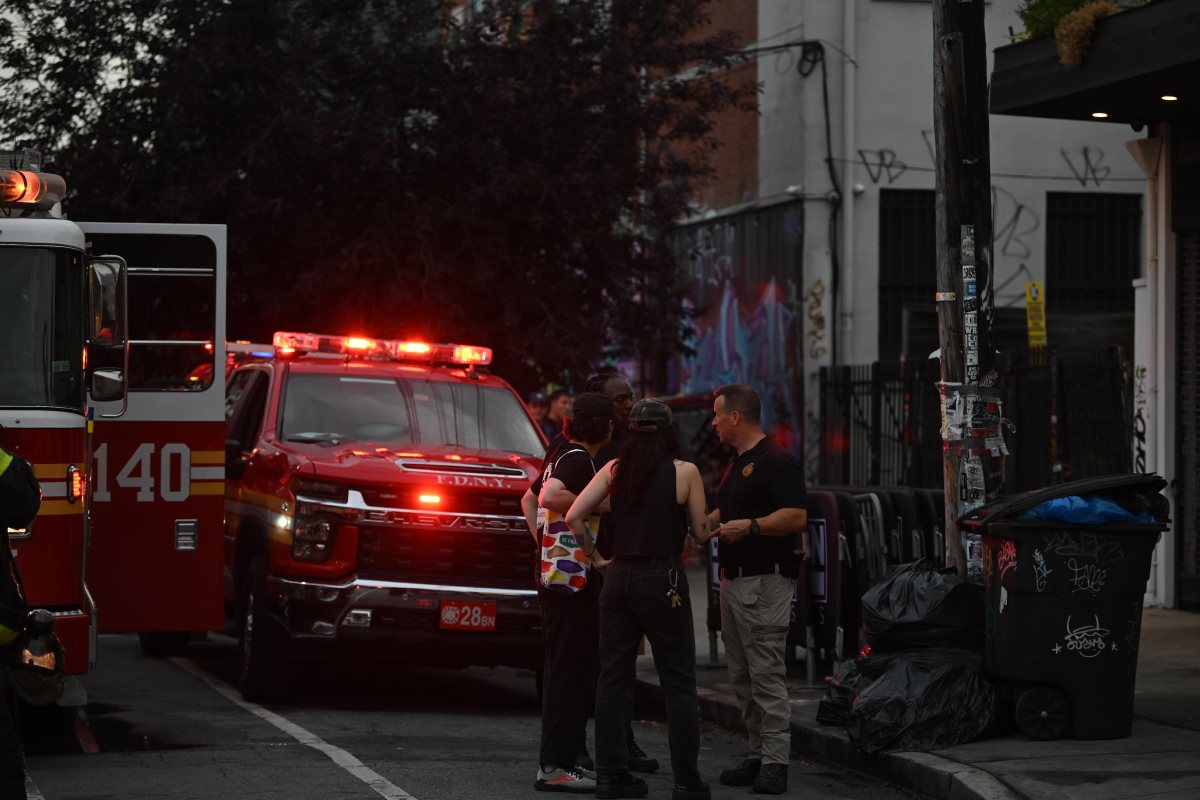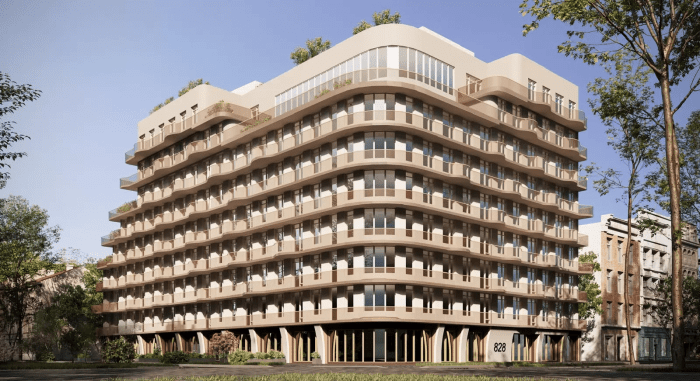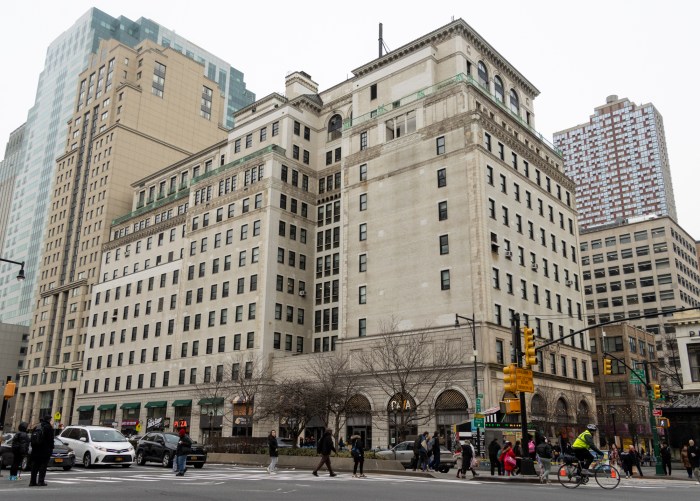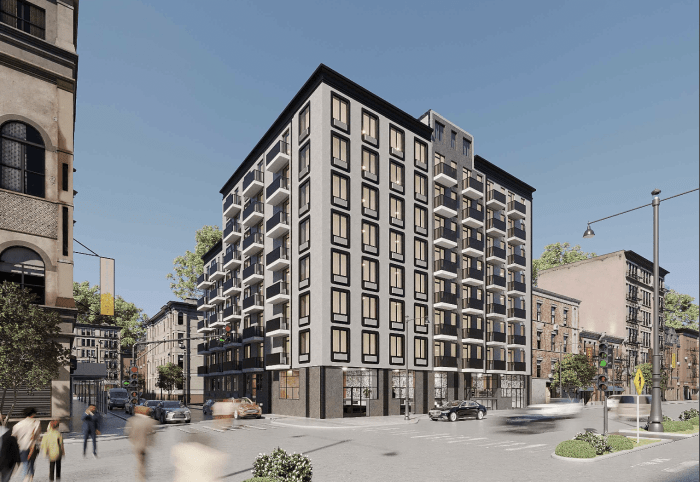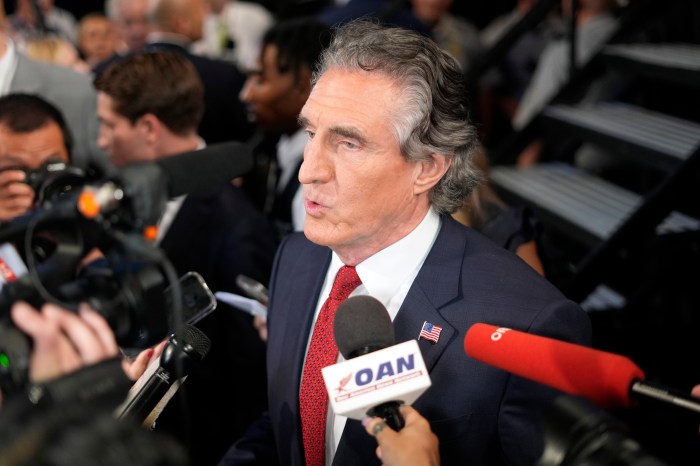A deal binding a community organization to developer Bruce Ratner’s
contentious Atlantic Yards project, anticipated since last fall, has finally
arrived.
The pact, between Ratner and ACORN, a national organization, was sealed
— literally — with a kiss.
ACORN Executive Director Bertha Lewis planted wet ones on both Mayor Michael
Bloomberg and Ratner at a media event staged in Brooklyn Borough Hall
on May 19. Lewis, Bloomberg and Ratner declined to answer most questions.
Ratner hopes to build a basketball arena and 17 office and housing high-rises
on 24 acres of property stretching east into Prospect Heights from the
intersection of Atlantic and Flatbush avenues.
The actual signing of the agreement, which was written as a memoradum
of understanding, will not take place until after various governmental
actions are taken that are necessary for the Atlantic Yards project to
proceed.
Bloomberg said the city would fund a “50-50” affordable housing
scheme on the Ratner site that would allow half of the proposed 4,500
residential units to be reserved for what has been described as low-,
moderate- and middle-income renters.
The other half of the six-block stretch would be rented at market rate.
Shaun Donovan, commissioner of the Department of Housing Preservation
and Development, said a 50-30-20 structure was contemplated, with the
20 percent being low-income units, 30 percent moderate and 50 percent
market-rate.
ACORN — an acronym for the Association of Community Organizations
for Reform Now — would be responsible for processing applications
for the low-, moderate- and middle-income units. ACORN’s activities
would be monitored by HPD, Donovan said.
No overall price tag was assigned at the Borough Hall event to the city’s
pledge, although it was stated that the Housing Development Corporation,
a city housing fund, might alone be on the hook for $67.5 million in subsidies.
“Developments [like the] one we envision at the Atlantic Yards, become
ever more important as our city’s housing prices continue to rise
almost exponentially,” said Bloomberg.
“We’ve all read the stories: Our red-hot real estate market
shows that our economy is growing, but it’s also a mixed blessing,
because as housing becomes more expensive, more longtime residents are
getting priced out of their own neighborhoods,” said Bloomberg to
a chorus of support from backers of the project who attended the event.
“We know, if you give people economic incentives to do things, they
respond the way they should be,” said Bloomberg, who congratulated
Borough President Marty Markowitz for promoting Ratner’s project.
The incentive for Ratner is an expectation that the HDC will offer him
1-percent tax-exempt mortgages for the construction of the project’s
moderate-income units.
“HDC adds up to $45,000 a unit to subsidize construction of the moderate-income
units,” explained HPD’s Donovan, whose agency would implement
HDC funding. “Just like tax-exempt bonds have a lower interest rate,
we give a 1 percent mortgage up to $45,000 per unit in exchange for the
developer to charge moderate-level rents.”
The 20 percent for low- and very low-income rentals are subsidized with
low-interest-rate, tax-exempt bonds and tax credits, said HDC spokeswoman
Tracy Paurowski.
“This agreement represents the first time that this concept of 50-50
has been implemented in a private agreement by a private developer in
a project of this scale,” Lewis said at Borough Hall. “And it
represents the first time that ACORN’s tiered income concept has
been implemented on such a large scale.”
According to the memorandum of understanding, 50 percent of the 2,250
below-market units will consist of studio and one-bedroom units.
Twenty percent, or 900 units, will go to housing for low-income residents
(earning from less than $18,014 for an individual to $36,438 for a family
of six) and very low-income residents (between $13,181 and $29,150). Another
900 units would go to two categories of middle-income, with 450 units
for each group, for singles earning less than $21,969 to $58,300 for a
family of six; and those earning from less than $35,589 as a single to
$72,875 for a family of six.
The remaining 450 below-market units would be divided into three categories
of moderate-income earners, which start at individuals making under $44,376,
$48,770 and $61,951 yearly up to families of six earning $102,035, $109,313
and $116,600, respectively.
A homeownership component may later be incorporated into the plan, according
to the memorandum.
Lewis, who is also co-chair of the Working Families Party, has staunchly
advocated for affordable housing on the project from the get-go. Lewis
has worked with the developer over the past 10 months to create a community
benefits agreement, detailing the housing scheme as well as local job
hiring agreements.
“One thing we have to acknowledge is the vision of Bruce Ratner,”
said Lewis.
Conspicuously absent was Councilwoman Letitia James, who made history
as the first candidate from the Working Families Party elected to City
Council. James, who represents Prospect heights, has from the beginning
been a staunch opponent of Ratner’s plan.
In a statement distributed at the Borough Hall event, James said, “I
continue to have concerns regarding the logic of locating a 20,000-seat
arena and 17 skyscrapers in the middle of a low-rise, brownstone community.”
“The community has been promised a report on the appraised value
of the MTA yards and they have yet to receive it. Moreover, the process
for development at the Atlantic Yards continues to bypass City Council
oversight and community involvement,” James added.
The wheeling and dealing behind the scenes was evidenced in the wording
in the memorandum of understanding, which included this paragraph:
“As long as the Project [the Atlantic Yards] will include the ACORN/ATLANTIC
YARDS 50/50 Program as described … ACORN agrees to take reasonable
steps to publicly support the Project by, among other things, appearing
with the Developer before the Public Parties, community organizations
and the media as part of a coordinated effort to realize and advance the
Project and the contemplated creation of affordable housing.”
Among the elected officials attending the Borough Hall event were City
Council members Sara Gonzalez (Red Hook-Sunset Park), Yvette Clarke (Flatbush),
James Sanders Jr. (Far Rockaway, Queens) and Lew Fidler (Canarsie-Mill
Basin); state Senators Marty Golden and Kevin Parker, and Assemblymen
Clarence Norman Jr., Roger Green and Joseph Lentol.
Sanders, as chairman of the Economic Development Committee, was scheduled
to host, on Thursday, May 26, the only council hearing on Atlantic Yards
prior to a vote on a $100 million allocation to the project in Bloomberg’s
Fiscal Year 2006 budget.
Lewis congratulated the Bloomberg administration and ACORN for their “commitment
to affordable housing,” saying it was “equally important that
there is a guarantee that this housing is permanently affordable.”
HPD spokeswoman Carol Abrams said that after the mortgage is paid off,
the units “would be subject to whatever the rent stabilization rules”
are at that time. She estimated the mortgages would carry 30-year terms.
The project is expected to be publicly reviewed only at the state level,
where it will be ushered through the process with the help of the Empire
State Development Corporation, which is responsible for completing an
environmental impact statement that is not dependent upon the approval
of any elected officials or local boards.
If you BUILD it they will come
At a much smaller meeting, two days before the Borough Hall event, Marie
Louis, first vice president of the neighborhood group BUILD, explained
to a reporter that the job benefits of a community benefits agreement
would be available to the public at large.
“Anybody who is in the radius of Brooklyn is pretty much a target
— it’s Brooklyn first and foremost,” she said.
Louis described “the missed opportunities of Metrotech” and
how the under-negotiation Atlantic Yards CBA was “a strategy to guard
against and overcome that.”
She said McKissack & McKissack, which bills itself as the nation’s
oldest minority-owned construction firm, was contracted by Forest City
Ratner to build the arena.
Forest City Ratner, which announced this week the hiring of Michael Hallmark,
an arena design and development expert who designed the Staples Center
in Los Angeles, Fleet Center in Boston, and renovated Madison Square Garden,
would not confirm if McKissack & McKissack had been hired.
But on Monday, listings were posted on BUILD’s Web site for employment
opportunities with McKissack & McKissack as project managers, assistant
project managers, superintendents and estimators.
Calls to the company, which built the Philadelphia Eagles’ new stadium
in 2003 and the stadium for the Tennessee Titans in 1999, were not returned
by press time.
BUILD President James Caldwell commended Ratner for being willing to negotiate.
“Let’s face it, this project is only $3 billion. We know it
won’t cure the ills of our community.
“But guess what? It brings us hope,” he said, adding, “And
Ratner knows by giving a little here, he’s getting back much more
in return.”











